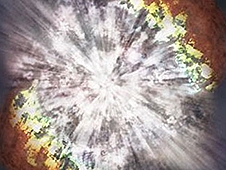
Giant massive bright stars, known as Wolf-Rayets, end their lives in great supernova explosions, according to a recent study.
The new discovery reveals new insights as to how these stars meet their fate. Wolf-Rayets are giant stars and are over 20 times the mass of the Sun and about five times hotter than Sun. These stars have extremely gigantic stellar winds and blows off huge amounts of materials at a speed of 2000 kilometers per second.
The breakthrough discovery was made by Avishay Gal-Yam and his colleagues of the Weizmann Institute in Israel. They identified the chemical nature and spectra of a windy Wolf-Rayet star present in the stellar debris from a supernova soon after a massive explosion.
Supernova occurs when stars that are massive than the sun suddenly collapse, resulting in an explosion that is immensely huge.
Gal-Yam and his colleagues used a procedure called as flash spectroscopy that can obtain the spectra of the star just few hours before the initial blast.
"If I compared this star to one of my computer models, I'd say this was a 27-solar mass star that lost about 17-solar masses in stellar winds, finally exploding with about a third of its original mass," ABC Science quoted Dr John Eldridge of the University of Auckland.
"We've identified red, blue and yellow supergiants that went supernova, but never a Wolf-Rayet. When you look at the statistics, you would have expected to see at least one of these Wolf Rayet stars because they're quite common." says Eldridge.
Scientists as a part of the study, used resources at the Energy Sciences Network and National Energy Research Scientific Computing Center, both of which located at the U.S. Department of Energy's Lawrence Berkeley National Laboratory.
According to scientists, some of the giant stars become Wolf-Rayets during their final stages of lives and amplifies galaxies with chemical elements that in due course of time help to become planets. Researchers are on their process of determining which stars tend to explode and the elements produced by these stars as they disintegrate.
"This discovery was totally shocking, it opens up a whole new research area for us. With our largest telescopes, you might have a chance of getting a spectrum of a Wolf-Rayet star in the nearest galaxies to our Milky Way, perhaps 4 million light years away. SN 2013cu is 360 million light years away—further by almost factor of 100." said Peter Nugent of the Berkeley Lab.
Wolf-Rayet stars have massive cores due to which they may not create a neutron star as they explode and rather become black holes, according to computer based models.
"We always thought they may die with a whimper because if you form a black hole there's nothing to bounce off and no energy will be produced. It's much more difficult to have a very bright supernova so we didn't expect to see any of these stars explode as supernova." said Eldridge.
The details of the finding have been published in the journal Nature.















